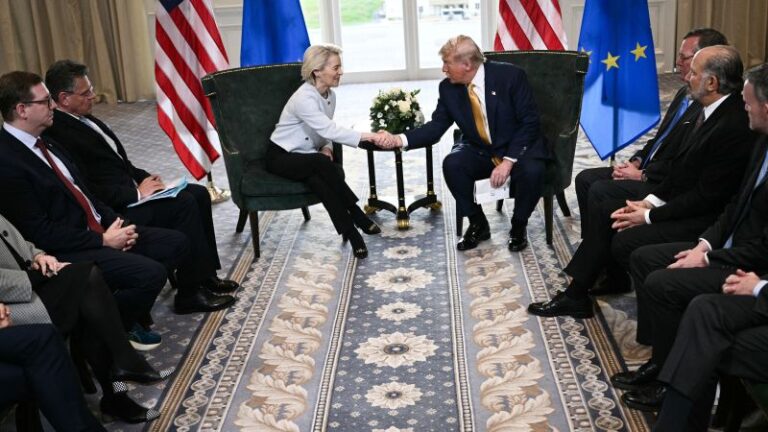The United States and the European Union avoided the worst-case scenario: a damaging, all-out trade war between allies that threatened to raise prices on a large number of goods and slow two of the world’s largest economies. The framework delivered a sense of relief for both sides – but few are cheering the arrangement itself.
The agreement, which sets a 15% tariff on most European goods entering the United States, is higher than the 10% tariff Trump put in place on April 2 and significantly higher than the average of around 2% from before Trump’s presidency. But it’s significantly less than the enormous numbers Trump had been threatening if an agreement wasn’t reached.
A deal with the United States felt like an impossibility in late May. Frustrated by a lack of progress in negotiations with the 27-member European Union, Trump on May 24 told the world he was done talking to some of America’s strongest allies.
“Our discussions with them are going nowhere!” Trump posted on Truth Social.
“I’m not looking for a deal,” he said later that day in the Oval Office. “We’ve set the deal — it’s at 50%.”
The statement — and the shockingly high tariff threat — stunned European trade negotiators and rallied Europe’s leaders into action. They quickly agreed to kick talks into high gear.
Trump, who has taken a particular liking to European Commission President Ursula von der Leyen, was swayed after she called him to say the EU would commit to moving “swiftly and decisively.” Trump soon backed off his threat and said negotiations would continue.
But a deal between the United States and the European Union, one of America’s top trading partners, had remained elusive for months. The two sides squabbled over America’s insistence on high tariffs for steel and aluminum, looming tariffs on pharmaceuticals and the tariff floor for virtually all goods that the Trump administration appears set to raise to 15%.
Negotiators were unable to come up with a resolution before the initial July 9 deadline — one of the reasons the Trump administration postponed the effective day for its “reciprocal” tariffs to August 1. With just days to go before the extended deadline, while Trump was visiting Scotland, he met with van der Leyen and finalized a framework for an agreement — one that was thin on details, heavy on caveats, but was nevertheless a hard-sought relief for both sides.
With the agreement in place, two of the world’s largest economies avoided a potential economically crippling trade war. The United States held a 50% tariff threat over Europe’s head, and Europe threatened America with strategic retaliatory tariffs that threatened to damage key US industries.
Both sides appeared to embrace the fact that a deal was in place more than they celebrated it.
“We made it,” Trump said while announcing the deal with von der Leyen. “It’s going to work out really well.”
“I think we hit exactly the point we wanted to find,” von der Leyen said. “Rebalance but enable trade on both sides. Which means good jobs on both sides of the Atlantic, means prosperity on both sides of the Atlantic and that was important for us.”
Markets cheered, somewhat: Dow futures rose 150 points, or 0.3%, poised to open near record territory. S&P 500 futures gained 0.3% and Nasdaq futures were 0.4% higher.
The United States and Europe “seem to have avoided a self-destructive trade war for now in the biggest and deepest commercial and investment relationship the global economy knows,” said Jörn Fleck, senior director of the Atlantic Council’s Europe Center.
Nevertheless, the details remain murky. Europe will increase its investment in the United States by $600 billion and commit to buying $750 billion worth of US energy products. It eliminates tariffs on a variety of items, including aircraft and plane parts, semiconductors, generic drugs and some chemicals and agricultural products.
Industries in the zero-tariff arrangement cheered.
“The zero-for-zero tariff regime will grow jobs, strengthen our economic security and provide a framework for U.S. leadership in manufacturing and safety,” Airlines for America said in a statement.
But the 15% baseline tariff applies to most goods, so the EU member states – and American importers — will have to come to terms with the fact that higher tariffs will raise prices for European goods in America.
“Higher tariffs mean higher prices for US consumers—and that will seriously dent EU companies’ bottom lines,” said Alex Altmann, vice president of the British Chamber of Commerce in Germany. “EU companies aiming to stay competitive in the US market will think twice when deciding where to produce or assemble.”
The agreement also deals another blow to Detroit automakers, which objected to a similar deal the Trump administration reached with Japan. The 15% auto tariff on EU cars imported to the United States undercuts the 25% tariff American automakers pay if their cars are built in Mexico.
Although von der Leyen said pharmaceuticals were included in the early framework, she acknowledged that Trump may ultimately place higher tariffs on drugs imported to the United States, undercutting the agreement.
Still, in the eyes of the hard-working negotiators — and for the sake of the global economy — a deal is better than no deal. Now comes the hard part: figuring out the details.


